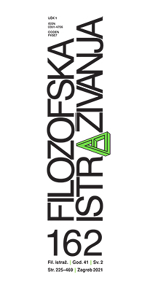Povijesni slojevi teksta Bhagavadgīte – predaja teksta, proširenja i preoblike pouke. Što je zajedničko Bhagavadgīti i katedrali sv. Duje?
Historical Layers of Bhagavadgītā – the Transmission of the Text, Its Expansion and Reinterpretations. What Do Bhagavadgītā and the Cathedral of Saint Dominus Have in Common?
Author(s): Mislav JežićSubject(s): Ethics / Practical Philosophy, Indian Philosophy, Philosophy of Religion, Sociology of Religion
Published by: Hrvatsko Filozofsko Društvo
Keywords: Bhagavadgītā; Kṛṣṇārjunasaṃvāda; sāṃkhya; yoga; pūrvamīmāṃsā; vedānta; Proto-Bhagavadgītā; bhakti; Cathedral of Saint Dominus; text history; analysts; unitarians;
Summary/Abstract: The Bhagavadgītā is often considered the holiest text of Hinduism. It was commented by a legion of commentators, and a number of philologists, starting with Wilhelm von Humboldt, tried to establish the layers of its text, which shows traces of several redactions. Some scholars noticed some seams in the text correctly (Friedrich Otto Schrader, Hermann Oldenberg, Hermann Jacobi), and some came close to a general picture of the text history (Jarl Charpentier, Angelika Malinar, Gajanan Shripad Khair, Purushottam Lal Bhargava). On the other hand, many scholars were discouraged by the uncertainties in the investigation of the text history and preferred to interpret the Gītā as an indivisible whole (Paul Deussen, Douglas Hill, Etienne Lamotte, Franklin Edgerton, Robert Zaehner). However, between the 1970s and 2009, it was possible to come to very precise results concerning the textual layers of the Bhagavadgītā, which were internationally largely accepted since ca. 2000. These results imply that, over time, views of several philosophical systems (sāṃkhya, yoga, mīmāṃsā, monistic and theistic vedānta) were incorporated into the poem, as well as polemics with different (often unnamed) doctrines (especially with Buddhism, but also with the Vedas, yoga, monistic vedānta, and even dharmaśāstra). The teachings and exhortations conveyed by the poem are very synthetic and innovative because they are derived from a very complex set of premises. These results of text analyses have been, on the one hand, accepted by a number of prominent scholars worldwide (John Brockington, Georg von Simson, Horst Brinkhaus, Gavin Flood, Przemyslaw Szczurek, Ivan Andrijanić, Robert Zydenbos), but, on the other hand, fiercely contested by some Western post-modernist scholars of religion (Alf Hiltebeitel) and by some scholars of Indian origin sensibilised negatively against Western scholarship (Vishwa Adluri, Joydeep Bagchee). What they lack in their reading of the Bhagavadgītā can best be made clear by means of the comparison with a visitor to an artistic monument of a religious character, which underwent centuries of modifications, like the Split cathedral. If such a visitor considered that the sanctity and artistic credibility of a monument depended on its being completely constructed at one stroke by a single architect with a single conception, he would miss the complex, sometimes even polemical, rich and impressive way in which such a monument conveys its messages. This is the fruit of the long and complex history of the Split cathedral, that was first built as the mausoleum of a Roman emperor, and later turned into the church consecrated to his victims, passing thereafter through many subsequent modifications and ‘reinterpretations’. In the history of art, such prejudices are not as common as they are in the study of sacred texts. That is why a suitable example of a monument having religious character, like the Split cathedral of the Assumption of Virgin Mary, also consecrated to Diocletian’s victims Domnius and Anastasius, can best illustrate how we should understand a literary monument of a religious and philosophical character, like the Bhagavadgītā, which underwent a comparably complex history.
Journal: Filozofska istraživanja
- Issue Year: 41/2021
- Issue No: 02/162
- Page Range: 247-272
- Page Count: 26
- Language: Croatian

